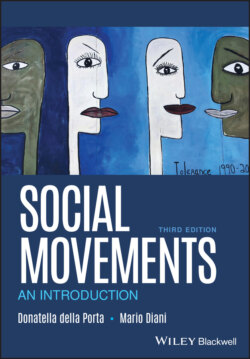Social Movements

Реклама. ООО «ЛитРес», ИНН: 7719571260.
Оглавление
Donatella della Porta. Social Movements
Table of Contents
List of Illustrations
Guide
Pages
Social Movements. An Introduction
Foreword to the Third Edition
ACKNOWLEDGMENTS
CHAPTER 1 The Study of Social Movements: Recurring Questions, (Partially) Changing Answers
1.1 FOUR CORE QUESTIONS FOR SOCIAL MOVEMENT ANALYSIS
1.1.1 Is Social Change Creating the Conditions for the Emergence of New Movements?
1.1.2 How Do We Define Issues as Worthy Objects, and Actors as Worthy Subjects, of Collective Action?
1.1.3 How Is Collective Action Possible?
1.1.4 What Determines the Forms and Intensity of Collective Action?
1.1.5 Are These Questions Specific to Social Movement Analysis?
1.2 WHAT IS DISTINCTIVE IN SOCIAL MOVEMENTS?
1.2.1 The Concept of Social Movement
1.2.2 Conflictual and Consensual Collective Action
1.2.3 Social Movements, Events, and Coalitions
1.2.4 Social Movements and Organizational Processes
1.2.5 Social Movements and Protest
1.3 IN THIS BOOK
CHAPTER 2 Social Changes and Social Movements
2.1 SOCIAL STRUCTURE, POLITICAL CLEAVAGES, AND COLLECTIVE ACTION
2.2 STATES, MARKETS, AND SOCIAL MOVEMENTS
2.2.1 Globalization and Protest
2.2.2 State and Classes: The Conflicts around the Welfare State
2.3 KNOWLEDGE, CULTURE, AND CONFLICTS
2.3.1 Shifting Boundaries between the Public and the Private
2.3.2 Cultures and Countercultures
2.3.3 Between the Global and the Local
2.4 STRUCTURAL TRANSFORMATIONS, NEW CONFLICTS, NEW CLASSES
2.4.1 Still Classes?
2.4.2 Which Class Base for Which Social Movements?
2.4.3 Labor and Protest
2.4.4 Movements of the Crisis?
2.5 SUMMARY
CHAPTER 3 The Symbolic Dimension of Collective Action
3.1 CULTURE AND ACTION: THE ROLE OF VALUES
3.2 CULTURE AND ACTION: THE COGNITIVE PERSPECTIVE
3.2.1 Interpretative Frames
Diagnostic Element
Prognostic Element
Motivational Element
3.2.2 Ideology and Master Frames
3.2.3 Frame Alignment
3.3 PROBLEMS AND RESPONSES
3.4 SUMMARY
CHAPTER 4 Collective Action and Identity
4.1 IDENTITY AS A CONDITION AND A PROCESS
4.2 IDENTITY AND TIME
4.3 MULTIPLE IDENTITIES
4.4 HOW IS IDENTITY GENERATED AND REPRODUCED? 4.4.1 Self‐ and Hetero‐Definitions of Identity
4.4.2 Production of Identity: Symbols, Practices, and Rituals
4.4.3 Identity and the Political Process
4.5 SUMMARY
CHAPTER 5 Individuals, Networks, and Participation
5.1 NETWORKS AND PARTICIPATION
5.2 DO NETWORKS ALWAYS MATTER?
5.3 INDIVIDUALS AND ORGANIZATIONS
5.3.1 Exclusive Affiliations
5.3.2 Multiple Affiliations
5.4 INDIVIDUAL PARTICIPATION, MOVEMENT SUBCULTURES, AND VIRTUAL NETWORKS
5.5 SUMMARY
CHAPTER 6 Organizations and Organizing within Social Movements
6.1 ORGANIZATIONS WITHIN SOCIAL MOVEMENTS
6.1.1 Professional Protest Organizations
6.1.2 Transnational Social Movement Organizations
6.2 PARTICIPATORY MOVEMENT ORGANIZATIONS
6.2.1 Mass Protest Organizations
6.2.2 Grassroots Organizations
6.3 FROM ORGANIZATIONS TO ORGANIZING: MODES OF COORDINATION OF COLLECTIVE ACTION
6.4 DO WE STILL NEED ORGANIZATIONS? COMMUNICATION TECHNOLOGY AND COLLECTIVE ACTION
6.5 HOW DOES ORGANIZING WITHIN SOCIAL MOVEMENTS CHANGE?
6.5.1 Changes within Specific Groups or Associations
6.5.2 Changes in the Structure of Fields
6.6 SUMMARY
CHAPTER 7 Eventful Protests
7.1 DEFINING PROTEST
7.2 THE LOGICS AND FORMS OF PROTEST
7.2.1 The Logic of Numbers
7.2.2 The Logic of Damage
7.2.3 The Logic of Bearing Witness
7.2.4 Prefiguration and Movements
7.3 STRATEGIC OPTIONS AND PROTEST REPERTOIRES
7.4 PROTEST SPREADING IN TIME AND SPACE
7.4.1 Cycles of Protest, Protest Waves, and Protest Campaigns
7.4.2 The Cross‐National Diffusion of Protest
7.5 EVENTFUL PROTEST
7.6 SUMMARY
CHAPTER 8 Political Opportunities for Social Movements
8.1 POLITICAL INSTITUTIONS AND SOCIAL MOVEMENTS
8.2 PREVAILING INSTITUTIONAL STRATEGIES
8.3 SOCIAL MOVEMENTS’ OPPONENTS
8.3.1 Noninstitutional Opponents
8.3.2 The Policing of Protest
8.4 ALLIES AND SOCIAL MOVEMENTS
8.4.1 Unions and Movements
8.4.2 Social Movements and Parties
8.5 DISCURSIVE OPPORTUNITY AND THE MEDIA SYSTEM
8.6 SUMMARY
CHAPTER 9 The Effects of Social Movements
9.1 SOCIAL MOVEMENT EFFECTS: SOME CAVEATS
9.2 CHANGES IN PUBLIC POLICY
9.3 SOCIAL MOVEMENTS AND PROCEDURAL CHANGES
9.4 SOCIAL MOVEMENTS AND DEMOCRATIZATION
9.5 NORMATIVE CONCEPTIONS OF DEMOCRACY IN MOVEMENT
9.6 SUMMARY
References
Index
WILEY END USER LICENSE AGREEMENT
Отрывок из книги
THIRD EDITION
Donatella della Porta and Mario Diani
.....
We can look at these actions in more detail:
Collective identity building also entails actors establishing connections between different occurrences, private and public, located at different points in time and space, which are relevant to their experience, and weaving them in broader, encompassing narratives (Melucci 1996; Tilly 2005). As a result, organizational and individual actors involved in collective action no longer merely pursue specific goals, but come to regard themselves as elements of much larger and encompassing processes of change – or resistance to change. For example, in 2011, participants in events as distant as the Indignados square occupations in Spain and the anti‐government protests in Tunisia or Egypt might have felt to be linked together through processes of identity building based upon the shared call for greater democracy and supranational communication. Within social movements, membership criteria are extremely unstable and ultimately dependent on mutual recognition between actors; the activity of boundary definition – i.e., of defining who is and who is not part of the network – indeed plays a central role in the emergence and shaping of collective action (Melucci 1996, ch.3).
.....